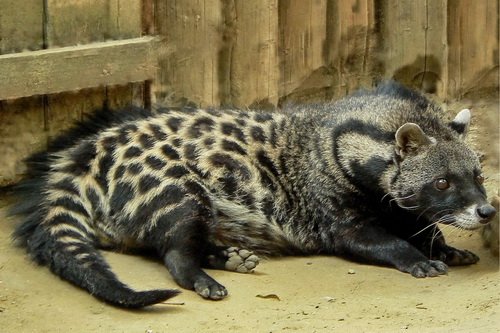Not a Bear and Not a Cat
Viverridae
by Inspector Barry Mins on November 14, 2023Hey kids, welcome back to our series on the mysteries of created kinds.
Last week, we finalized our name for our resident cormorant—Cormelius. I checked in on him yesterday (as of this writing), and he is enjoying the unseasonably warm weather we are having here at the Creation Museum.
Last week, we met a colorful group of birds with lots of variety. This week, we meet a small group of mammals mostly from the Old World, which includes Europe, Asia, and Africa.

Members of this kind are found in a variety of habitats, including shrublands1 and forests. They tend to avoid higher elevations but will gladly use lower elevation rocky habitats.2 Some members of this kind can have unique color patterns like albinism (which makes them very light) and melanism (which makes them very dark).3 They have relatively broad ranges for small mammals, sometimes averaging over four square miles.4 However, daily movements were often well less than a mile.5 Some species prefer the treetops, while others prefer to stay on the ground.6
Members of this kind are commercially farmed for their scent which is used to make perfume.7 Their diet varies widely, with some species being primarily carnivorous, dining mostly on insects and small mammals.8 Others depend on fruits, with figs being their favorite fruit.9 Other members of the kind are omnivores, mixing and matching from fruits and live prey.10
Because members of this kind are often solitary and live in remote areas, very little is known for certain about their reproduction in the wild. Most of the information we have comes from camera traps, places in the wild where motion-triggered cameras are hidden to take pictures of animals. In captivity, they will produce as many as four kits in a litter and up to three litters a year.11
Has anyone figured it out yet? This week’s kind is the Viverridae—the Viverrid (Civet) kind. We have a representative of this kind at our Ark Encounter zoo—a binturong, otherwise called a bear cat, from the jungles of Southeast Asia. Stay tuned for next week when we meet a colorful snake kind.
Try out this fun word search!
Clue
Your clue for the week is:
There is only one species in this kind, and it is found only in the northern half of South America.
Ask a Question
Have you ever had a question about created kinds but didn’t know who to ask? Have you ever wanted to learn more about your favorite kind? Well, now you can! You can ask me, Inspector Barry Mins, a question! Have your parents help you fill out this form, and you might get your question answered in my column! If you have any questions about created kinds, feel free to send them my way!
Footnotes
- Emilio Virgós, Teresa Romero, and Julián G. Mangas, “Factors Determining ‘Gaps’ in the Distribution of a Small Carnivore, the Common Genet (Genetta genetta), in Central Spain,” Canadian Journal of Zoology, 79 (2001): 1544–1551, https://digital.csic.es/bitstream/10261/282370/1/factorspain.pdf.
- Emilio Virgós and Jorge G. Casanovas, “Habitat Selection of Genet Genetta genetta in the Mountains of Central Spain,” Acta Theriologica 42, no. 2 (1997): 169–177, https://rcin.org.pl/ibs/Content/12682/PDF/BI002_2613_Cz-40-2_Acta-T42-nr16-169-177_o.pdf.
- Miguel Delibes, Virginie Mézan-Muxart, and Javier Calzada, “Albino and Melanistic Genets (Genetta genetta) in Europe,” Acta Theriologica 58, (2013): 95–99, https://digital.csic.es/bitstream/10261/73219/1/acta%20theriol.pdf.
- Simon Thirgood, Ermias Admasu, Afework Bekele, and M. Karen Laurenson, “A Note on the Spatial Ecology of African Civet Civettictis civetta and Common Genet Genetta genetta in Farmland in the Ethiopian Highlands,” African Journal of Ecology 42 (2004): 160–162, Google Scholar.
- Lon I. Grassman, Jr., Michael E. Tewes, and Nova J. Silvy, “Ranging, Habitat Use and Activity Patterns of Binturong Arctictis binturong and Yellow-Throated Marten Martes flavigula in North-Central Thailand,” Wildlife Biology 11, no. 1 (2005): 49–57, https://onlinelibrary.wiley.com/doi/pdf/10.2981/0909-6396%282005%2911%5B49%3ARHUAAP%5D2.0.CO%3B2.
- Su Su and John Sale, “Niche Differentiation Between Common Palm Civet Paradoxurus hermaphroditus and Small Indian Civet Viverricula indica in Regenerating Degraded Forest, Myanmar,” Small Carnivore Conservation 36, (April 2007): 30–34, Google Scholar.
- D. Mullu and M. Balakrishnan, “Ecology of African Civet (Civettictis civetta) in Arba Minch Forest, Arba Minch Ethiopia,” Science, Technology and Arts Research Journal 3, no. 3 (2014): 99–102, https://doi.org/10.4314/star.v3i3.16.
- M. Delibes, A. Rodriguez, and F. F. Parreno, “Food of the Common Genet (Genetta genetta) in Northern Africa,” Journal of the Zoological Society of London 218 (1989): 321–326, https://digital.csic.es/bitstream/10261/39775/1/Delibes_J%20Zool_89.pdf.
- Miyabi Nakabayashi and Abdul Hamid Ahmad, “Short-Term Movements and Strong Dependence on Figs of Binturongs (Arctictis binturong) in Bornean Rainforests,” European Journal of Wildlife Research 64, no. 66 (2018): https://borneoficus.info/wp-content/uploads/2019/03/Nakabayashi-2018-Binturongs-short-term-movements-and-strong-dependence-on-figs.pdf.
- Yayoi Kaneko, Masakazu Iwama, Koji Yamazaki, Miho Matsuyama, Yoshinobu Hoshino, Masumi Hisano, and Chris Newman, “Masked Palm Civet Paguma larvata Summer Diet Differs Between Sexes in a Suburban Area of Central Japan,” Mammal Study 42, no. 3 (2017): 185–190, https://ora.ox.ac.uk/objects/uuid:0e8af944-08e0-4a85-b147-82422b990048/download_file?file_format=pdf&safe_filename=Iwama%2Bet%2Bal.%252C%2BMasked%2Bpalm%2Bcivet%2BPaguma%2Blarvata.pdf&type_of_work=Journal+article.
- Takele Taye Desta, “The African Civet Cat (Viverra civetta) and Its Life Supporting Role in the Livelihood of Smallholder Farmers in Ethiopia,” Conference on International Research on Food Security, Natural Resource Management and Rural Development, October 6–8, 2009, https://www.researchgate.net/profile/Takele-Desta/publication/237100122_The_African_civet_cat_Viverra_civetta_and_its_life_supporting_role_in_the_livelihood_of_smallholder_farmers_in_Ethiopia/links/5a4cb76da6fdcc3e99d09d7a/The-African-civet-cat-Viverra-civetta-and-its-life-supporting-role-in-the-livelihood-of-smallholder-farmers-in-Ethiopia.pdf.
- © 2024 Answers in Genesis
- Privacy Policy
- Contact
- About


